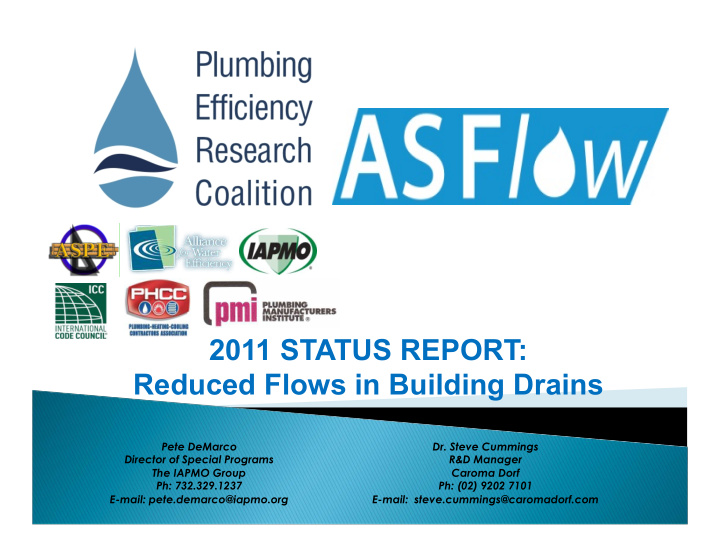



2011 STATUS REPORT: Reduced Flows in Building Drains Pete DeMarco Dr. Steve Cummings Director of Special Programs R&D Manager The IAPMO Group Caroma Dorf Ph: 732.329.1237 Ph: (02) 9202 7101 E-mail: pete.demarco@iapmo.org E-mail: steve.cummings@caromadorf.com
The Good News: New water efficient fixtures and appliances are reducing demand on potable water The Not-So-Good News: We have some concerns Health and Safety Systemic Efficacy Drainline transport concerns are inhibiting the use of High Efficiency Toilets The US EPA is delaying the development of WaterSense™ specification for commercial HETs pending research
ASPE joins PERC in 2011 ! Funding for drainline research has yet to be received Scope of proposed research reduced in 2010 to lower cost Focus of revised scope: 1. Evaluation of intermittent high volume “flush” to avoid drainline blockage occurrences 2. Determination of the importance of the design of the toilet in drainline transport relative to other plumbing system design considerations
Lab based testing 200 - 300 foot drainline apparatus, location TBD 4 inch diameter pipe (most common, worst case) System variables: pitch and flush volume Toilet design variables: percent flush water training solids and flow rate Analysis of data will rank significance of these variables and determine interactions Intermittent “clearing flush” at 1% and 2% frequency Cost using revised scope of work - $170K Yes, we still need funding!
December 2010: ASFlow and PERC Sign MoU at EPA HQ First ever international MoU focusing on plumbing research Objective – “…research collaboration...for studying the sanitary flow and addressing any consequences of reduced water usage from water conservation measures, reduction in water usage by plumbing fixtures, and other drivers to reduce household and commercial water usage.”
Goals of MoU Investigate current Australian, US and overseas research activities to avoid duplication of research Review current knowledge on impacts of reduced flows on sanitary plumbing and drainage systems Identify and quantify knowledge gaps Compare installation and design practices Communicate with overseas research groups on research methodologies
Excellent work continues Down Under Study on horizontal junctions completed in 2010 (presented at 2010 4 th WSI) Junction Test Media / Results will be basis of Paper Waste Back plumbing code revisions Flow
Excellent work continues Down Under Toilet paper testing 22 brands of commercially available brands tested Toilet paper characteristics varied by # of ply, texture, weight
Toilet Paper Media Study – Determination of performance characteristics No.5 No.8 No.12 Test Paper Characteristics Test Paper Characteristics Test Paper Characteristics Sheet Size: 11x10cm Sheet Size: 11x10cm Sheet Size: 11x10cm Ply: 2 Ply: 1 Ply: 2 Weight (g) of 10 sheets: 3.8g Weight (g) of 10 sheets: 3.6g Weight (g) of 10 sheets: 5.1g Poorest Performing Nearest the Average Best Performing Size, Ply and Weight
Toilet Paper Media Study – Results Combination of solids and paper reduce drainline performance
Toilet Paper Media Study – Low Cost Predictive Tests? Water Absorption Test or Tensile Strength Test Correlation to Drain Line Transport Distance? Water Absorption Test Test Time until samples: sample becomes 6 Sheets TP saturated Crumpled as in MaP test Count # of washers at failure
Toilet Paper Media Study – Low Cost Predictive Tests? Water Absorption Test or Wet Tensile Strength Test Correlation to Drain Line Transport Distance? Wet Tensile Strength Test Test samples: Soak for 60 Plastic Cup seconds Rubber band 1 sheet TP Count # of Add washers washers at 1 at a time failure
Toilet ¡Paper ¡Sample ¡# ¡ Brand ¡#5 ¡ Brand ¡ ¡#8 ¡ Brand ¡#12 ¡ Brand ¡#5 ¡ Brand ¡ ¡#8 ¡ Brand ¡#12 ¡ Wet ¡Tensile ¡Strength ¡(# ¡washers) ¡ 9 ¡ 39 ¡ 22 ¡ 11 ¡ 26 ¡ 22 ¡ Absorp<on ¡Time ¡(sec) ¡ 3 ¡ 4 ¡ 4 ¡ 3 ¡ 4 ¡ 3 ¡ DLC ¡w/ ¡MaP ¡(m) ¡ 27 ¡ 11 ¡ 16 ¡ 27 ¡ 11 ¡ 16 ¡ DLC ¡/w ¡AS ¡(m) ¡ 12 ¡ 10 ¡ 13 ¡ 12 ¡ 10 ¡ 13 ¡ DLC ¡w/ ¡TP ¡alone ¡(m) ¡ 60 ¡ 38 ¡ 52 ¡ 60 ¡ 38 ¡ 52 ¡ ~ ¡4 ¡seconds ¡between ¡ Correla7on ¡– ¡Tensile ¡Strength ¡ trial ¡#1 ¡ trial ¡#2 ¡ adding ¡washers ¡ Wet ¡tensile ¡strength ¡/ ¡DLC ¡MaP ¡ -‑0.95823 ¡ -‑0.99875 ¡ Wet ¡tensile ¡strength ¡/ ¡DLC ¡AS ¡ -‑0.71074 ¡ -‑0.43546 ¡ Wet ¡tensile ¡strength ¡/ ¡DLC ¡alone ¡ -‑0.99685 ¡ -‑0.91335 ¡ Correla7on ¡– ¡Water ¡Absorp7on absorp<on ¡<me ¡/ ¡DLC ¡Map ¡ -‑0.95222 ¡ -‑0.2116 ¡ absorp<on ¡<me ¡/ ¡DLC ¡AS ¡ -‑0.18898 ¡ 0.755929 ¡ absorp<on ¡<me ¡/ ¡alone ¡ -‑0.77771 ¡ 0.155543 ¡ Conclusion: Appears to be a very strong correlation (inverse) between DLC result w/ Map and Toilet Paper only media and Toilet Paper Tensile Strength Test
Questions? THANK YOU!
Recommend
More recommend